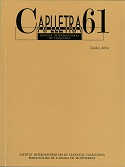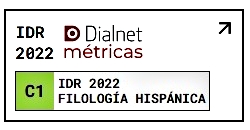A diachronic study of the (negative) additive anche in Italian
DOI:
https://doi.org/10.7203/caplletra.60.8456Keywords:
additive, negative additives, focus, aspectual marker, grammaticalization Abstract
Abstract
Abstract: In Modern Italian (MI), negative additives are focalizing elements that typically obey negative concord with a clausal negation or another licensing negative element. In this paper we investigate the diachronic evolution of one negative additive element, neanche ‘neither/not even’. In Old Italian (OI, Florentine variety of 1200-1370), there is no evidence of morphologically complex negative additive focalizers such as neanche. Instead, the non-negative additive counterpart of neanche, anche, could combine with a negative marker or some other negative element: e.g. né/non… anche ‘neither/not even’. We show that, in OI, (i) the morphologically non-negative additive anche can be used both as a negative and as a positive polarity item; (ii) anche can function either as an aspectual marker with the meaning ‘(not) yet’, or as an additive focalizer with the meaning ‘neither/not even’; (iii) its different interpretations are mirrored by different syntactic positions, i.e. anche has an aspectual interpretation in the postverbal position taking scope over a verbal phrase (vP), and it has an additive interpretation in the preverbal position taking scope over a determiner phrase (DP); and (iv) anche triggers a focus semantic interpretation under both conditions: as an additive and an aspectual marker (see Rooth 1985, Chierchia 2013 on focus semantics).
We account for the diachronic evolution from neg(ation) + anche in OI to neanche in MI by suggesting that the grammaticalization of neanche originates from a particular construction in which the additive anche is immediately to the right adjacent to the negative disjunction né (i.e. né+anche>neanche).
Key words: additive, negative additives, focus, aspectual marker, grammaticalization.
 Downloads
Downloads
Downloads
Published
How to Cite
-
Abstract841
-
PDF (Català)339
Issue
Section
License
Authors submitting work to Caplletra for publication must be the legitimate holder of the usage rights. Legitimacy for the purposes of publishing the work must also include images, tables, diagrams and any other materials that may complement the text, whether they are the author of such material or not.
Copyright: on publishing their work in the journal, the author grants Caplletra. Revista Internacional de Filologia usage rights (reproduction, distribution and public communication) for both the paper printed version and for the electronic version.
All work published in Caplletra is covered by the Creative Commons license type Attribution-NonCommercial-NoDerivatives 4.0 (CC BY-NC-ND 4.0).
RESPONSABILITY
Caplletra. Revista Internacional de Filologia does not necessarily identify with the points of view expressed in the papers it publishes.
Caplletra. Revista Internacional de Filologia accepts no responsibility whatsoever for any eventual infringement of intellectual property rights on the part of authors.






